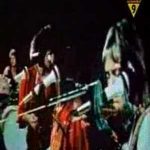Nights in White Satin – The Moody Blues
“Nights in White Satin” is a classic song by the British rock band The Moody Blues. Written and composed by the band’s lead singer and guitarist, Justin Hayward, it was first released in 1967 on their album “Days of Future Passed.” Hayward wrote the song at the age of 19, inspired by a gift of white satin sheets from a girlfriend just before embarking on a tour. The song captures the emotions of longing and heartbreak.
The song is part of “Days of Future Passed,” a concept album that combines rock music with orchestral arrangements. This album portrays a single day’s cycle from dawn to night, and “Nights in White Satin” represents the evening. The lush orchestration, arranged by Peter Knight and performed by the London Festival Orchestra, blends rock elements with classical music, showcasing the band’s innovative approach to progressive rock. The song is known for its haunting melody, emotional lyrics, and distinctive use of the Mellotron, an early keyboard instrument that simulates orchestral sounds.
The lyrics of “Nights in White Satin” reflect themes of love, longing, and existential reflection, with the phrase “nights in white satin” evoking a sense of melancholy and nostalgia. The album version of the song ends with a spoken-word poem titled “Late Lament,” written by the band’s drummer, Graeme Edge, and recited by keyboardist Mike Pinder. This poem adds a philosophical dimension to the song, exploring themes of life’s transient nature.
“Nights in White Satin” became one of The Moody Blues’ most successful and enduring hits. Initially released as a single in 1967, it reached number 19 on the UK Singles Chart. The song was re-released in 1972 and became a bigger hit in the United States, reaching number 2 on the Billboard Hot 100 chart. Its blend of rock and classical music, deeply emotional lyrics, and innovative instrumentation has made it a standout track in the history of rock music.
The song is considered a classic of the progressive rock genre and has been covered by numerous artists. Its timeless appeal continues to resonate with audiences, and it remains a staple in The Moody Blues’ live performances. “Nights in White Satin” has appeared in various films, TV shows, and advertisements, further cementing its status as a cultural icon. Its evocative sound and lyrical depth have made it a favorite among fans and critics alike, exemplifying The Moody Blues’ ability to push the boundaries of the genre and create a lasting musical legacy.








January 17, 2022 @ 10:31 am
Smooth, light, dreamy, AND LOVELY LYRICS ! Love it.
January 16, 2019 @ 10:57 pm
i have loved this song also since hearing it the first time in 1967.. really showing my age now..
January 11, 2021 @ 2:45 pm
That is not tooo bad, if you were just born when you heard it the first time, I was already 13 that year….Now, that is old!
lol
November 4, 2017 @ 7:47 pm
Another Winner!
November 11, 2016 @ 3:42 pm
This cam out when I was 11 years old, I fell in love with it then and am still loving it.
October 22, 2016 @ 6:43 pm
This is one of the songs that “the love of my life” and I share as one of “ours”. When you love and share your life with someone for more than 4 decades, you find you have more than one song that you call special. This one however, is our first “our” song!!! Love you sweetheart!!!
October 21, 2016 @ 10:13 pm
Thank you from the bottom of my heart for putting on one of the most beautiful, romantic, sensuous songs on earth by one the the most wonderful, sincerest music groups we have ever heard !! It still brings tears to our eyes and brings back many memories!